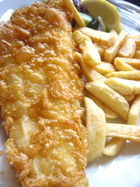French fries
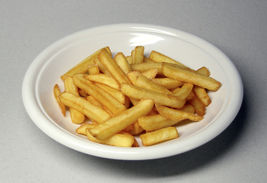 A dish of French fries |
|
| Origin | |
|---|---|
| Alternative name(s) | Freedom fries, Belgian fries, chips, fries, French-fried potatoes, steak fries, wedges |
| Place of origin | Belgium |
| Dish details | |
| Course served | Side dish or, rarely, as a main dish |
| Serving temperature | Hot, generally salted, with or without a side of ketchup or other dips, like vinegar |
| Main ingredient(s) | Potatoes and oil |
French fries (North American English, sometimes capitalized[1]), fries,[2] or French-fried potatoes are thin strips of deep-fried potato.[3] North Americans often refer to any elongated pieces of fried potatoes as fries, while in other parts of the world, most notably the United Kingdom, Australia, Ireland and New Zealand, long, thinly cut slices of fried potatoes are sometimes called fries to distinguish them from the thickly cut strips called chips.[4] French fries are known as frites or pommes frites in many parts of Europe as well as French speaking Canada, and have names that mean "fried potatoes" or "French potatoes" in others.
Contents |
Etymology

The French term 'frite' (passive past participle of frire) in 'pommes de terre frites' unambiguously denotes deep frying, unlike the English 'fried', which may also refer to sautéing or pan-frying, so 'French fried' may simply mean 'deep-fried'.[5][6] Thomas Jefferson at a White House dinner in 1802 served "potatoes served in the French manner".[5][7][8] In the early 20th century, the term "French fried" was being used for foods such as onion rings or chicken, apart from potatoes.[9][10]
It is unlikely that 'French fried' refers to 'frenching' in the sense of "julienning" as this term is specific to green beans,[11] and is in any case not attested until after 'French fried potatoes'; previously, Frenching referred only to trimming the meat off the shanks of chops.[12]
Culinary origin
Belgium
The Belgian journalist Jo Gérard recounts that potatoes were fried in 1680 in the Spanish Netherlands, in the area of "the Meuse valley between Dinant and Liège, Belgium. The poor inhabitants of this region allegedly had the custom of accompanying their meals with small fried fish, but when the river was frozen and they were unable to fish, they cut potatoes lengthwise and fried them in oil to accompany their meals."[13][14][15]
Many Belgians believe that the term "French" was introduced when American soldiers arrived in Belgium during World War I, and consequently tasted Belgian fries. They supposedly called them "French", as it was the official language of the Belgian Army at that time.
"Les frites" (French) or "Frieten" (Dutch) became the national snack and a substantial part of several national dishes.
Great Britain
Chips
The first chips fried in Britain were apparently on the site of Oldham's Tommyfield Market in 1860. In Scotland, chips were first sold in Dundee, "...in the 1870s, that glory of British gastronomy – the chip – was first sold by Belgian immigrant Edward De Gernier in the city’s Greenmarket."[16] Traditional "chips" in the United Kingdom and Ireland are usually cut much thicker, typically between 9.5–13 mm (⅜ - ½ inches) square in cross-section and cooked twice (although double frying is less commonly practiced today), making them more crunchy on the outside and fluffier on the inside. Since the surface-to-volume ratio is lower, they have a lower fat content. Thick-cut British chips are sometimes, but not exclusively, made from unpeeled potatoes to enhance their flavor and nutrional content, and are not necessarily served as crisp as the European French fry due to their higher relative water content.
Chips are part of the popular take-out dish fish and chips. In the United Kingdom, Australia, Ireland, and New Zealand, few towns are without a fish and chip shop. In these countries, the term "French fries" refers to the narrow-cut (shoestring) fries that are served by American-based fast food franchises.
France and French speaking Canada
In France and French speaking Canada, fried potatoes are called "pommes de terres frites" , "pommes frites" or more simply (and commonly) "frites". Pomme frites are somewhat different than American French fries in that they are often fried twice, use different oils to fry them, and also different types of potatoes are used.
Eating potatoes was promoted in France by Parmentier, but he did not mention fried potatoes in particular.
Many Americans attribute the dish to France and offer as evidence a notation by U.S. President Thomas Jefferson. "Pommes de terre frites à cru, en petites tranches" ("Potatoes deep-fried while raw, in small cuttings") in a manuscript in Thomas Jefferson's hand (circa 1801-1809) and the recipe almost certainly comes from his French chef, Honoré Julien.[5] In addition, from 1813[17] on, recipes for what can be described as French fries, occur in popular American cookbooks. By the late 1850s, one of these mentions the term "French fried potatoes".[18]
Spain
In Spain, fried potatoes are called "patatas fritas". Another common form in which the potatoes are cut into irregular shapes and seasoned with a spicy tomato sauce, are called "patatas bravas".
Some claim that the dish was invented in Spain, the first European country in which the potato appeared via the New World colonies, and assumes the first appearance to have been as an accompaniment to fish dishes in Galicia, from which it spread to the rest of the country and further to the Spanish Netherlands, which became Belgium more than a century later.
Professor Paul Ilegems, curator of the Friet-museum in Antwerp, Belgium, believes that Saint Teresa of Ávila fried the first chips, referring also to the tradition of frying in Mediterranean cuisine.[15][19]
Spreading popularity
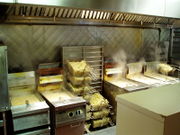
United States influence
Although the thicker cut European style of fried potato (known as chips) was already a popular dish in most Commonwealth countries, the thin style of French fries has been popularized worldwide in part by U.S.-based fast food chains such as McDonald's.
Pre-made French fries have been available for home cooking since the 1970s, usually having been pre-fried (or sometimes baked), frozen and placed in a sealed plastic bag.
The classic French fry container seen in many fast food restaurants was invented by John Freyman, an immigrant from England, in the late 1930s.
Later varieties of French fries include those which have been battered and breaded, and many U.S. fast food and casual-food chains have turned to dusting with kashi, dextrin, and flavors coating for crispier fries with particular tastes. Results with batterings and breadings, followed by microwaving, have not achieved widespread critical acceptance. Oven frying delivers a dish different from its traditionally fried counterpart.[20]
Variants
There are variants such as "thick-cut fries", "steak fries", "shoestring fries", "jojo fries", "crinkle fries", and "curly fries". Fries cut thickly with the skin left on are called potato wedges, and fries without the potato skin are called "steak fries", essentially the American equivalent of the British "chip". They can also be coated with breading, spices, or other ingredients, which include garlic powder, onion powder, black pepper, paprika, and salt to create "seasoned fries", or cheese to create cheese fries, or chili to create chili fries. Sometimes, French fries are cooked in the oven as a final step in the preparation (having been coated with oil during preparation at the factory): these are often sold frozen and are called "oven fries" or "oven chips". Some restaurants in the southern and northeastern United States, particularly New Jersey, New York, Massachusetts, and Louisiana, offer French fries made from sweet potatoes instead of traditional potatoes.
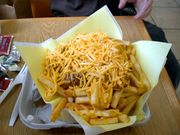
In France, the thick-cut fries are called "Pommes Pont-Neuf"[21] or simply "pommes frites", about 10 mm; thinner variants are "pommes allumettes" (matchstick potatoes), ±7 mm, and "pommes pailles" (potato straws), 3–4 mm (roughly ⅜, ¼ and ⅛ inch respectively). The two-bath technique is standard (Bocuse). "Pommes gaufrettes" or "waffle fries" are not typical French fried potatoes, but actually crisps obtained by quarter turning the potato before each next slide over a grater and deep-frying just once.[22]
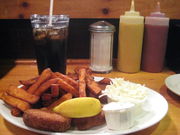
Jean Ceustermans, a Belgian chef patented "steppegras" ("prairie grass"), his variety of extremely thin-cut French fried potatoes developed in 1968 while working in Germany. The name refers to a dish including its particular sauce, and to his restaurant.[23]
In an interview, Burger King president Donald Smith said that his chain's fries are sprayed with a sugar solution shortly before being packaged and shipped to individual outlets. The sugar caramelizes in the cooking fat, producing the golden color customers expect. Without it, the fries would be nearly the same color outside as inside: pasty yellow. Smith believes that McDonald's also sugar-coats its fries. McDonalds was assumed to fry their fries for a total time of about 15 to 20 minutes, and with fries fried at least twice. The fries appear to contain beef tallow, or shortening.[24]
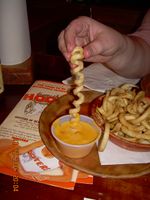
Curly fries
Curly fries are a kind of French fry characterized by their unique spring-like shape. They are generally made from whole potatoes that are cut using a specialised spiral slicer. They are also typically characterized by the presence of additional seasonings (which give the fries a more orange appearance when compared to the more yellow appearance of standard fries), although this is not always the case.
Sometimes they are packaged for preparation at home, often in frozen packs. In the US they can also be found at a number of restaurants and fast food outlets like Arby's and Hardee's, where they are served with condiments such as ketchup, cheese, fry sauce, or sweet chili sauce and sour cream.
Accompaniments
French fries are almost always salted just after cooking. They are then served with a variety of condiments, notably vinegar (especially malt vinegar), salt, ketchup, curry, curry ketchup (mildly hot mix of the former), hot or chili sauce, mustard, mayonnaise, bearnaise sauce, tartar sauce, tzatziki, feta cheese, garlic sauce, fry sauce, ranch dressing, barbecue sauce, gravy, aioli, brown sauce, lemon, piccalilli, pickled cucumber, gherkins, very small pickled onions, or honey.[25][26]
Health aspects

French fries can contain a large amount of fat (usually saturated) or oils from frying. Some researchers have suggested that the high temperatures used for frying such dishes may have results harmful to health (see acrylamides). In the United States about ¼ of vegetables consumed are prepared as French fries and are proposed to contribute to widespread obesity. Frying French fries in beef tallow, lard, or other animal fats adds saturated fat to the diet. Replacing animal fats with tropical oils such as palm oil simply substitutes one saturated fat for another. Replacing animal fats with partially hydrogenated oil reduces cholesterol but adds trans fat, which has been shown to both raise LDL cholesterol and lower HDL cholesterol. Canola oil could also be used, but beef lard is generally more popular, especially amongst fast food outlets that use communal oil baths. The picture on the right shows French Fries being cooked on a gas stove for fast oil temperature re-gain and better heat control.[27][28][29] Many restaurants now advertise their use of unsaturated oils. Five Guys, for example, advertises their fries are prepared in peanut oil.
Legal issues
In 1994 Peter Stringfellow, the well-known owner of Stringfellows nightclub in London, took exception to McCain Foods' use of the name "Stringfellows" for a brand of long thin French fries and took them to court. He lost the case (Stringfellows v McCain Food (GB) Ltd (1994)) on the basis that there was no connection in the public mind between the two uses of the name, and therefore McCain's product would not have caused the nightclub to lose any sales.[30][31]
In New Zealand in 1995 some branches of the local fast food chain Georgie Pie took to calling their French fries "Kiwi Fries", in opposition to the French resumption of nuclear testing in the South Pacific.
In early 2003 some members of the United States Congress caused French fries to be renamed "freedom fries" in the restaurant of the House of Representatives in response to France's opposition to the proposed invasion of Iraq. By 2006 the menu at the House restaurant had reverted to calling them French fries.[32]
In June 2004, the United States Department of Agriculture, with the advisement of a federal district judge from Beaumont, Texas, classified batter-coated French fries as a vegetable under the Perishable Agricultural Commodities Act. Although this was primarily done for trade reasons – French fries do not meet the standard to be listed as a "processed food" – it received significant media attention partially due to the documentary Super Size Me.
See also
- Chip pan
- Carne asada fries
- Deep fryer
- Deep frying
- Freedom fries
- Fry sauce
- Home fries
- Potato wedges
- Poutine
- Pommes soufflées
- Vacuum fryer
- Tater Tots
References
- Notes
- ↑ "french fries - Definition". Merriam-Webster Online Dictionary. 2007-04-25. http://www.merriam-webster.com/dictionary/french+fries. Retrieved 2009-05-07.
- ↑ "The American Heritage Dictionary, Fourth Edition, 2000". Bartleby.com. http://www.bartleby.com/61/68/F0346800.html. Retrieved 2009-05-07.
- ↑ "french fry - Definition". Food & Culture Encyclopedia. http://www.answers.com/topic/french-fry. Retrieved 2009-12-05.
- ↑ Halliburton, Rachel; Muir, Jenni (2008). "London's best chips". Time Out London: p. 2. http://www.timeout.com/london/restaurants/features/3254/2.html. Retrieved 2008-05-14.
- ↑ 5.0 5.1 5.2 Hess, Karen (November 2005). "The Origin of French Fries". PPC (Petits Propos Culinaires), journal of food studies and food history (3×/year by Prospect Books, Devon) (68): 39. http://www.kal69.dial.pipex.com/shop/pages/ppc68.htm#French%20fries. Retrieved 25 April 2010.
- ↑ "Objets de la recherche : frite" (in French). ATILF Analyse et traitement informatique de la langue française, TLFi Le trésor de la langue française informatisé. http://atilf.atilf.fr/dendien/scripts/tlfiv5/search.exe?26;s=484685130;cat=1;m=frite;. Retrieved 23 March 2007. "Part. passé substantivé au fém. de frire*, p. ell. de pommes de terre dans le syntagme pommes de terre frites."
- ↑ Suman Bandrapalli (May 2, 2000). "Where do French fries come from?". Christian Science Monitor. http://www.csmonitor.com/2000/0502/p18s1.html. Retrieved 2009-07-05. "Thomas Jefferson sampled them in Paris and brought the recipe home. At a White House dinner in 1802, the menu included "potatoes served in the French manner." But that's not how they got their name."
- ↑ Fishwick, Marshall W (1998). fee required "The Savant as Gourmet". The Journal of Popular Culture (Oxford: Blackwell Publishing) 32 (part 1): 51–58. doi:10.1111/j.0022-3840.1998.3201_51.x. http://www.blackwell-synergy.com/doi/abs/10.1111/j.0022-3840.1998.3201_51.x fee required.
- ↑ Mackenzie, Catherine (7 April 1935). "Food the City Likes Best". The New York Times Magazine: SM18. http://select.nytimes.com/gst/abstract.html?res=F4081FF83B59107A93C5A9178FD85F418385F9. Retrieved 2007-04-15. "… the chef at the Rainbow Room launches into a description of his special steak, its French-fried onion rings, its button mushrooms …".
- ↑ Rorer, Sarah Tyson (c1902). "Page 211". Mrs. Rorer's New Cook Book. Philadelphia: Arnold & Company. p. 211. http://digital.lib.msu.edu/projects/cookbooks/coldfusion/display.cfm?ID=rore&PageNum=259. Retrieved 2007-04-12. "French Fried Chicken"
- ↑ Merriam-Webster's Collegiate Dictionary, 10th ed.
- ↑ Oxford English Dictionary, June 2010
- ↑ "The One and Only Belgian fries website". Belgianfries.com. 2009-01-16. http://www.belgianfries.com/bfblog/?page_id=189. Retrieved 2009-05-07.
- ↑ J. Gérard, Curiosités de la table dans les Pays-Bas Belgiques, s.l., 1781.
- ↑ 15.0 15.1 Ilegems, Paul (1993) [1993] (in Dutch). De Frietkotcultuur. Loempia. ISBN 90-6771-325-2.
- ↑ "Dundee Fact File". Dundee City Council. http://www.dundeecity.gov.uk/departments/fact.htm. Retrieved 20 March 2007.
- ↑ Ude, Louis. The French Cook
- ↑ Warren, Eliza (uncertain: 1856, 1859?). The economical cookery book for housewives, cooks, and maids-of-all-work, with hints to the mistress and servant. London: Piper, Stephenson, and Spence. p. 88. OCLC 27869877. http://books.google.com/?id=AkMCAAAAQAAJ&dq=eliza+warren+cookery+%7C+cookbook+%7C+cooking&q=%22french+fried+potatoes%22. "French fried potatoes"
- ↑ Schoetens, Marc (December 13, 2005). "Heilige Teresa bakte de eerste frieten" (in Dutch). De Morgen. http://www.demorgen.be/gastronomie/artikels/?id_article=ODA4&ih=h=h=. Retrieved October 25, 2006. (Feb 25 2007 found archived as "Nieuw boek van frietprofessor Paul Ilegems over frietkotcultuur" 20051213.3133206672696574)
- ↑ Gerdes, Sharon (1 December 2001). "Batters and Breadings Liven Tastes". Virgo Publishing © – Food Product Design. http://www.foodproductdesign.com/articles/465/465_1201de.html. Retrieved 24 March 2007.
- ↑ Evelyn Saint-Ange, Paul Aratow (translator), La Bonne Cuisine de Madame E. Saint-Ange: The Essential Companion for Authentic French Cooking, Larousse, 1927, translation Ten Speed Press, 2005, ISBN 1-58008-605-5, p. 553.
- ↑ "Les pommes gauffrettes" (in French). "Chef Simon" Sabine et Bertrand SIMON cole. http://chefsimon.com/gaufrette.htm. Retrieved 9 April 2007.
- ↑ "Steppegras" (in Dutch). Restaurant Steppegras. http://www.steppegras.org. Retrieved 17 April 2007.
- ↑ Poundstone, William (1983) [1983]. Big Secrets. William Morrow and Co.. p. 23. ISBN 0-688-04830-7.
- ↑ "Side Dishes: International French Fries". Food Services of America. http://www.fsafood.com/fsacom/News+and+Information/Solutions/Menuing/International+French+Fries.htm. Retrieved 28 November 2006.
- ↑ "Les sauces servies traditionnellement avec les frites en Belgique: Les pickles belges (Belgian Pickles)" (in French). belgourmet. http://www.belgourmet.be/fr/frites/belgian_pickles.php. Retrieved 12 January 2007.
- ↑ "Fats and Cholesterol". Harvard School of Public Health. http://www.hsph.harvard.edu/nutritionsource/fats.html. Retrieved 14 September 2006.
- ↑ "Trans: The Phantom Fat". Nutrition Action Healthletter (Center for Science in the Public Interest). http://www.cspinet.org/nah/septrans.html. Retrieved 14 September 2006.
- ↑ Mayo Clinic Staff (22 June 2006). "Dietary fats: Know which types to choose © 1998-2006". Mayo Foundation for Medical Education and Research (MFMER). http://www.mayoclinic.com/health/fat/NU00262. Retrieved 14 September 2006.
- ↑ Solomon, Nicola. "Sequel opportunities". AKME Publications – Akme Student Law Library, with permission: earlier published in the New Law Journal, 25 March 1994 and in abriged form in The Author of Spring 1994. http://www.akme.btinternet.co.uk/solomn05.html. Retrieved 2007-03-25.
- ↑ "Section 7 – Intellectual Property" (PDF). Semple Piggot Rochez Ltd. 2001. http://www.legalpractitioner.co.uk/ip1.pdf. Retrieved 2007-03-25.
- ↑ Bellantoni, Christina (2006-08-02). "Hill fries free to be French again ; GOP in House mum about it". Washington Times: pp. A.01. ISSN 07328494.
- Bibliography
- Bocuse, Paul (December 10, 1998) (in French). La Cuisine du marché. Paris: Flammarion. ISBN 978-2082025188.
- Tebben, Maryann (2006). "“French” Fries: France’s Culinary Identity from Brillat-Savarin to Barthes (essay)". Convivium Artium. University of Texas at San Antonio. http://flan.utsa.edu/conviviumartium/Tebben.html. Retrieved December 28, 2009.
External links
- The Official French Fries Pages -- information and fan site (1996-pres.)
- News on French Fries and Potato Processing
|
|||||
|
||||||||
